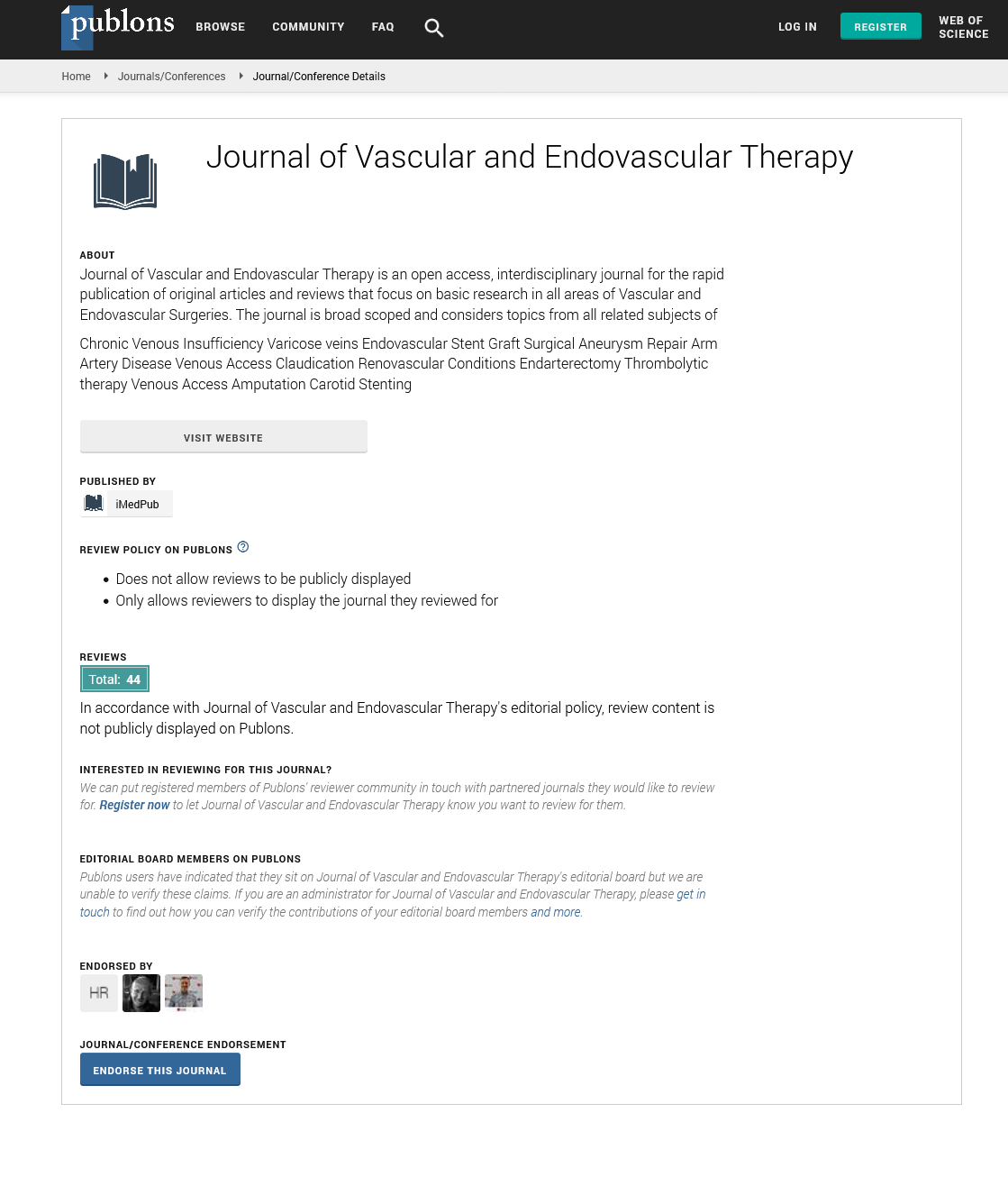ISSN : 2634-7156
Journal of Vascular and Endovascular Therapy
Distal hybrids for long chronic total occlusion of superficial femoral artery with severely compromised runoff
4th Edition of World Congress & Exhibition on Vascular Surgery
March 28-29, 2019 Rome, Italy
K Arshed, A Lipin, P Kuryanov, A Antropov, K Atmadzas, A Atmadzas, Y Eminov,A Borisov, R Sobolev and A Orlov
Limb Salvage Center,City hospital no.14, St.Petersburg, Russia
ScientificTracks Abstracts: J Vasc Endovasc Therapy
DOI: 10.21767/2573-4482-C1-005
Abstract
Statement of the Problem: Over two thirds of patients with critical limb ischemia (CLI) present with superficial femoral artery (SFA) disease, often a long chronic total occlusion (CTO) with patient popliteal artery and extensive occlusive lesions in the crural vessels. We studied a series of hybrid interventions to treat this multilevel disease as an alternative to conventional approach (either bypass or PVI).
Methodology & Theoretical Orientation: A total of 33 patients (24.2% women; mean age 69.5 years), all with Rutherford class 5-6 disease, were included in the study. Angiography showed long (>200 mm) SFA CTO in all 33 cases (100%) accompanied by CTO of either all crural arteries (n=26; 78.8%) or all but the peronea (n=7; 21.2%). We performed femoropopliteal bypass with autologous vein in all patients (100%) followed by crural angioplasty done either no the same day (n=14; 42.4%) or 2-14 days later (n=19; 52.6%). Direct angiosomic revascularization was achieved in 30 patients (91%).
Findings: The in-hospital complications were one death due to MI (3%); early graft failure in 2 patients (6%; both after simultaneous hybrid interventions); early major amputation in one (3%). The 1-year patency and the amputation-free survival were 66% and 75%, respectively. The 1-year healing rate was 93.4%.
Conclusion & Significance: In CLI patients with long SFA CTO and extensive crural disease a shorter bypass to a patent popliteal artery followed by crural angioplasty does not seem to increase the risk of early graft failure and provides fair long-term outcome.
Recent Publications
1. Walden R, Adar R, Rubinstein Z J and Bass A (2010) Distribution and symmetry of arteriosclerotic lesions of the lower extremities: an arterio-graphic study of 200 limbs. Cardiovasc Intervent Radiol. 8(4):180-2.
2. Bradbury A W, Adam D J, Bell J, Forbes J F, Fowkes F G, Gillespie I, Ruckley C V and Raab G M (2010) basil trial participants. bypass versus angioplasty in severe ischaemia of the leg (BASIL) trial: A description of the severity and extent of disease using the Bollinger angiogram scoring method and the TransAtlantic Inter- Society Consensus II classification. J Vasc Surg. 51(5 Suppl):32S-42S.
3. Davies M G, Saad W E, Peden E K, Mohiuddin I T, Naoum J J and Lumsden A B (2008) Impact of runoff on superficial femoral artery endoluminal interventions for rest pain and tissue loss. J Vasc Surg. 48(3):619-25.
4. Cotroneo A R, Iezzi R, Marano G et al. (2007) Hybrid therapy in patients with complex peripheral multifocal steno-obstructive vascular disease: two-year results. Cardiovasc Intervent Radiol 30:355–361.
5. Zhou M, Huang D, Liu C, Liu Z, Zhang M, Qiao T and Liu C J (2014) Comparison of hybrid procedure and open surgical revascularization for multilevel infrainguinal arterial occlusive disease. Clin Interv Aging 9:1595-603.
Biography
K Arshed has a MD grade in General Medicine and MS in Cardiovascular Surgery. At present he is pursuing PhD in Cardiovascular Surgery at St.Petersburg State Pediatric Medical University Department of Cardiovascular Surgery (Ministry of health of the Russian Federation) and practicing at city hospital no.14 under the supervision of Professor A N Lipin, researching on the topic “Revascularization of lower extremities during the course of occlusion of SFA in combination with severe lesions of the lower leg arteries”.
E-mail: drarshedcvs@gmail.com
Google Scholar citation report
Citations : 177
Journal of Vascular and Endovascular Therapy received 177 citations as per Google Scholar report
Journal of Vascular and Endovascular Therapy peer review process verified at publons
Abstracted/Indexed in
- Google Scholar
- Open J Gate
- Publons
- Geneva Foundation for Medical Education and Research
- Secret Search Engine Labs
Open Access Journals
- Aquaculture & Veterinary Science
- Chemistry & Chemical Sciences
- Clinical Sciences
- Engineering
- General Science
- Genetics & Molecular Biology
- Health Care & Nursing
- Immunology & Microbiology
- Materials Science
- Mathematics & Physics
- Medical Sciences
- Neurology & Psychiatry
- Oncology & Cancer Science
- Pharmaceutical Sciences
